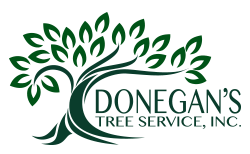The American Chestnut
The American Chestnut is probably one of the most beloved trees native to North America. We all know (and sing!) that all-time favorite holiday song about roasting chestnuts on an open fire! In fact, it wasn’t that long ago that this tree dominated the skyline. Legend says that forests from the Atlantic Ocean to the Mississippi River were so densely packed at one point that a squirrel could travel from the coast all the way to the Mississippi River without ever touching the ground! The majority of this forest was made up of the American Chestnut tree. Unfortunately, now the American Chestnut is critically endangered.
The American Chestnut was important to the fauna of the area and the population. The nuts were said to be better tasting, full of more nutrients, and bigger than the Chinese, Japanese, and European Chestnut species. The wood was rot resistant and strong, making it a great building material. And the trees were giants — growing up to 100 feet (or more!) with diameters of 10 feet wide. [1]
In 1904 a blight called Cryphonectrica parasitica was observed in the New York Zoological Gardens. [2] The blight first infected the trees in New York then quickly spread through all the American Chestnut trees in North America, attacking the trunk, limbs, and leaves of the tree. The roots remained healthy and little sprouts would pop up from the roots to grow another tree, however they too would succumb to the blight. It did not take long after the initial sighting for nearly all the American Chestnuts in the United States to be wiped out. By the 1950s, the American Chestnut was considered extinct. [2]
Prior to the blight, some southern American Chestnuts had suffered from Ink disease in the 1800’s. [1] Ink disease affected the roots of the trees, slowly killed them. [3] The combination of Ink disease and the blight, was devastating to this species.
However, although these trees are critically endangered, they are not extinct. In fact, there are some in the northern Virginia region, which is really awesome! [4] Most of the trees in this area are smaller and still show signs of the blight, which means they may not grow large enough to fruit or become the giants they once were. But that’s okay! They still exist and that gives us hope that we can help restore these magical trees.
Scientists have been working for many decades to try and revive the American Chestnut. They are close to combating the blight and we hope that they will find a solution soon. Imagine having an American Chestnut in your backyard. It would also be amazing to see them populating our forests and neighborhoods once again.
References:
[2] https://www.britannica.com/science/chestnut-blight
[3] http://www.chestnutgrowers.org/resources.html
Informational Links:
· https://en.wikipedia.org/wiki/American_chestnut
· https://www.esf.edu/chestnut/
· https://acf.org/va/about/chestnut-story/
· https://ecosystems.psu.edu/research/chestnut/breeding/blight/control-blight
· https://en.wikipedia.org/wiki/American_chestnut
· https://irma.nps.gov/DataStore/Reference/Profile/2217458
· https://srs.fs.usda.gov/uplandhardwood/research/article/american-chestnut-restoration

